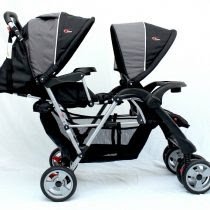Get the proper understanding of how a double pram works
Purchasing a twin buggy might be difficult. You'll probably require answers to at least some of the often asked questions answered in this post when you look at the numerous various twin buggies available.
1. How are twin prams, twin strollers, twin buggies, and twin pushchairs different?
Different terminologies are used depending on where you are, and the names have grown to imply different things than they used to. The words "twin pram," "twin buggy," and "twin pushchair" are all used interchangeably in the UK, while the term "twin stroller" is less frequent. A "pram" used to refer to a wheeled infant bed, but it is now also used to refer to more upright modes of transportation. The term "twin" refers to both the side-by-side and tandem varieties of twin pushchairs (one child behind the other).
2. Are there any twin prams that will accept car seats from any manufacturer?
Although there are rare exceptions, each manufacturer produces car seats to match their own prams. A car seat carrier is the best option if you want something really universal that can carry any car seat. This is essentially a frame that can be used with any car seat.
3. Many twin prams feature non-removable seat coverings. What's the most effective technique to clean them?
The ideal alternative is to install detachable seat coverings, but if that is not possible, brush off any debris and large filth first, then saturate a cloth with mild soap and water and wash down the seats until they are clean. Don't wet the seats, and avoid using any detergent that can irritate them.
4. You may reverse the seats in certain buggies so that your youngster faces you. Is it possible to do this with a double pram/pushchair?
Yes, you may buy twin prams with completely adjustable seat configurations so that one or both children can face you. These models are on the more expensive side of the market, therefore they aren't the cheapest.

.jpg)


Comments
Post a Comment